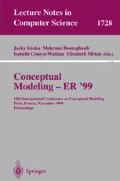Abstract
In a conceptual schema that includes specializations and generalizations, and that allows multiple classification, an entity may be, at a given time, instance of one or more entity types. We call type configuration of an entity the set of entity types of which it is instance at some time. In this paper, we characterize the set of valid type configurations, taking into account the constraints defined by specializations and generalizations. We also analyze the problem of determining the valid evolution of the type configuration of entities in the context of IsA hierarchies. We describe the temporal features of entity types and the evolution constraints that influence entity evolution. In particular, we propose and define the specialization evolution constraints, which extend the classical distinction between static and dynamic entity types. Taking into account all these features and constraints, we characterize the set of valid type configuration transitions. In both cases, we tackle the problem for the general class of conceptual schemas, allowing multiple specialization, generalization and classification, as well as dynamic classification.
Access this chapter
Tax calculation will be finalised at checkout
Purchases are for personal use only
Preview
Unable to display preview. Download preview PDF.
References
Boman, M., Bubenko jr. J.A., Johannesson, P. and Wangler, B. “Conceptual Modelling”, Prentice Hall, 1997.
Batini, C.; Ceri, S.; Navathe, S.B. “Conceptual Database Design. An Entity-Relationship Approach”. The Benjamin/Cummings Pub. Co., 1992.
Bergamaschi, S. and Sartori, C “Chrono: A conceptual design framework for temporal entities”. 17th Intl. Conf. on Conceptual Modeling (ER’98) — Singapore. LNCS 1507, pp. 35–50, 1998.
Bubenko, J.A.jr. “The Temporal Dimension in Information Modelling”, In “Architecture and Models in Data Base Management Systems”, North-Holland, pp. 93–113, 1977.
Costal, D.; Olivé, A. and Sancho, M-R. “Temporal Features of Class Populations and Attributes in Conceptual Models”. Proc. 16th. Intl. Conf. On Conceptual Modeling — ER’97, LNCS 1331, pp. 57–70, 1997.
de Champeaux, D.; Lea, D.; Faure, P. “Object-Oriented System Development.” Addison-Wesley Pub. Co., 1993.
Embley, D.W.; Kurtz, B.D.; Woodfield, S.N. “Object-Oriented Systems Analysis.” Yourdon Press., Prentice-Hall, Inc., 1992.
Halpin, T.A.; Proper, H.A. “Subtyping and polymorphism in object-role modelling”, Data & Knowledge Eng., 15, pp. 251–281, 1995.
Jungclaus, R.; Saake, G.; Hartmann, T.; Sernadas, C. “TROLL — A Language for Object-Oriented Specification of Information Systems”, ACM TOIS, 14, 2, April, pp. 175–211, 1996.
ISO/TC97/SC5/WG3. “Concepts and Terminology for the Conceptual Schema and the Information Base”, J.J. van Griethuysen (ed.), March 1982.
Lenzerini, M. “Covering and Disjointness Constraints in Type Networks”, Proc. ICDE87, pp. 386–393, 1987.
Martin, J.; Odell, J. “Object-Oriented Methods: A Foundation”. Prentice Hall, 1995.
Mostchnig-Pitrik, R.; Mylopoulos, J. “Classes and Instances”. Intl. J. of Intelligent and Cooperative Information Systems, Vol.1, No.1, pp. 61–92, 1992.
Mylopoulos, J. “Information modeling in the time of the revolution”, Information Systems, 23, 3/4, pp. 127–155, 1998.
Norrie, M.C.; Steiner, A.; Würgler, A. et al. “A Model for Classification Structures with Evolution Control”. Proc. 15th Intl Conf on Conceptual Modeling, LNCS 1157, pp. 456–471, 1996.
Olivé, A. “Relationship Reification: A Temporal View”. Procs. of the CAiSE’99. LNCS 1626, pp. 396–410, 1999.
Rumbaugh, J.; Blaha, M.; Premerlani, W.; Eddy, F.; Lorensen, W. “Object-Oriented Modeling and Design”. Prentice-Hall, Inc., 1991.
Rumbaugh, J.; Jacobson, I.; Booch, G. “The Unified Modeling Language Reference Manual”. Addison-Wesley, 1999.
Saltor, F.; Castellanos, M.; Garcia, M. et al. Modelling “Specialization as BLOOM Semilattices”. In “Information Modelling and Knowledge Bases”, IOS Press, Vol. VI., 1995.
Smith, J.M.; Smith, D.C.P. “Database Abstractions: Aggregation and Generalization”. ACM TODS, 2, 2, pp. 105–133, 1977.
Snoeck, M.; Dedene, G. “Generalization/specialization and role in object oriented conceptual modeling”, Data and Knowledge Engineering, 19, pp. 171–195, 1996.
Spaccapietra, S.; Parent, C.; Zimányi, E. “Modeling Time from a Conceptual Perspective”. CIKM, pp. 432–440, 1998.
Steiner, A.; Norrie, M.C. “Temporal Object Role Modelling”. Proc. 9th CAISE’97, LNCS 1250, pp. 243–258, 1997.
Su, J. “Dynamic Constraints and Object Migration”. Proc. 17th VLDB, Barcelona, pp. 233–242, 1991.
Tansel, A.; Clifford, J.; Gadia, S. et al. “Temporal Databases: Theory, Design and Implementation”. Benjamin/Cummings, 1993.
Theodoulidis, C.; Loucopoulos, P. “The Time Dimension in Conceptual Modelling”. Information Systems, 16, 3, pp. 273–300, 1991.
Theodoulidis, C.; Wangler, B.; Loucopoulos, P. “The Entity-Relationship-Time Model”. In “Conceptual Modeling, Databases and CASE. An Integrated View of Information Systems Development”, John Wiley & Sons, pp. 87–115, 1992.
Wieringa, R.; de Jonge, W.; Spruit, P. “Using Dynamic Classes and Role Classes to Model Object Migration”. TPOS, Vol 1 (1), pp. 61–83, 1995.
Author information
Authors and Affiliations
Editor information
Editors and Affiliations
Rights and permissions
Copyright information
© 1999 Springer-Verlag Berlin Heidelberg
About this paper
Cite this paper
Olivé, A., Costal, D., Sancho, MR. (1999). Entity Evolution in IsA Hierarchies. In: Akoka, J., Bouzeghoub, M., Comyn-Wattiau, I., Métais, E. (eds) Conceptual Modeling — ER ’99. ER 1999. Lecture Notes in Computer Science, vol 1728. Springer, Berlin, Heidelberg. https://doi.org/10.1007/3-540-47866-3_5
Download citation
DOI: https://doi.org/10.1007/3-540-47866-3_5
Published:
Publisher Name: Springer, Berlin, Heidelberg
Print ISBN: 978-3-540-66686-8
Online ISBN: 978-3-540-47866-9
eBook Packages: Springer Book Archive

